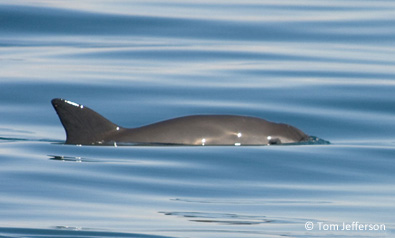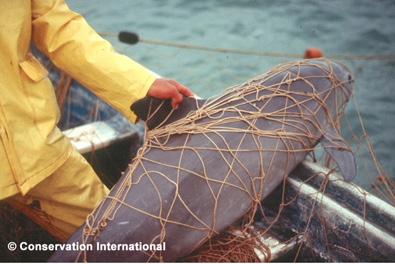
The vaquita porpoise (Phocoena sinus) is Mexico’s only endemic marine mammal. Along with dolphins, porpoises belong to the superfamily Delphinoidea. Now there are six living species of porpoise in the world, and the vaquita is the smallest and most endangered.
They have distinctive dark rings around the eyes and mouth, and contrary to what you might expect, female vaquitas are slightly larger than males, and they either travel alone or in very small groups. Like other porpoises, vaquitas use sonar to communicate and navigate, feeding on bony fish and squid on the sea bed. They have a very low reproductive rate of a single offspring per year after a long gestation period of roughly 11 months, which could prevent them recovering from population crashes. The oldest ever vaquita lived to 21 years of age.
This species has the most limited distribution of any marine cetacean. It is found only in shallow, murky lagoons along the shoreline, in waters no deeper than 30m at the northern end of the Gulf of California, most commonly around the Colorado River delta. The vaquita is unique in its ability to tolerate the huge fluctuations in water temperature there which range from 14°C in January to 30°C in August.

Vaquitas are vulnerable because they are rare and have such a limited distribution, and in early 2007 the population was shockingly estimated to be no more than 150 individuals, now classified as Critically Endangered by the IUCN.
They have never been hunted directly but the population is still declining as a result of death due to getting trapped in illegal gillnets set for various other marine creatures: when vaquitas get tangled in fishing nets they cannot surface to breathe, and therefore drown. It is estimated that up to 84 individuals die in this way each year. Juveniles are particularly susceptible to entanglement, and this may lead to a decrease in the number of reproductive adults, causing numbers to decline even faster.
Much of the vaquita’s habitat is located in the Colorado River Delta Biosphere Reserve which was set up in 1993. All forms of fishing are prohibited in the core area of this reserve but it is difficult to enforce these restrictions. In 1997 the Mexican government created the International Committee for the Recovery of the Vaquita (CIRVA) in conjunction with the WWF and other organisations, which identified fishery by-catch of vaquitas as the greatest and most immediate threat.

However, while banning gillnets and trawlers throughout the entire range of the vaquitas is the single measure most likely to prevent the species’ extinction, this move is likely to have profound political, cultural, social and economic implications in local communities and so has not really been implemented. Local communities have to be involved if this unique porpoise is to be saved, such as alternative sources of income for the local fishing communities and providing them with fishing gear that is harmless to the vaquita.
Help us fundraise so we can save species like the vaquita!